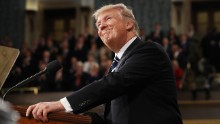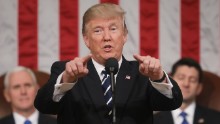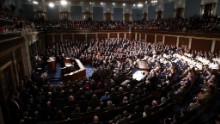Reality check: What was true, what was not true in Trump's spech
Trump speaks to Congress: CNN's Reality Check Team vets the claims
Updated 1:04 AM ET, Wed March 1, 2017
(CNN)President
Donald Trump on Tuesday addressed a joint session of Congress to
outline his legislative agenda, and CNN's Reality Check Team was there
to vet his claims.
The team of
reporters, researchers and editors across CNN listened throughout the
speech and analyzed key statements, rating them true, mostly true, true
but misleading, or false.
Crime
Reality Check: Murder rate single-year increase
By Ashley Killough and Jeremy Diamond, CNN
"The murder rate in 2015 experienced its largest single-year increase in nearly half a century," Trump said.
It's been a fact he's struggled with
both as president and on the campaign trail. Trump repeatedly said in
the past that the murder rate is the highest it's been in roughly 45
years, which is not accurate.
He got it right this time.
We rate his claim as true.
The United States did experience its highest one-year increase in the
murder rate in half a century between 2014 and 2015, according to FBI
Uniform Crime Reports.
One reason for the huge jump is that the murder rate in 2014 was so low, at 4.5 murders per 100,000 people.
Still,
even with the one-year increase, the murder rate for 2015 -- 4.9 per
100,000 people -- was lower than it was 45 years prior. In the 1990s,
for example, the murder rate hovered between eight and 10 murders per
100,000 people.
Trump added there were more than 4,000 people shot last year in Chicago, which is also true. In fact, there were 4,331 shooting victims, according to the Chicago Police Department.
Pipelines
Reality Check: Trump on pipeline jobs
By Laura Koran, CNN
Trump
asserted his administration's support of the Keystone XL and Dakota
Access pipelines are "creating tens of thousands of jobs."
The
remark wasn't the first time Trump touted the job-creating potential of
the two controversial pipelines. Last month, when Trump signed an
executive order paving the way for construction to move forward, he
claimed Keystone XL alone would create 28,000 "great construction jobs."
But how accurate are his estimates?
A
State Department report on the Keystone XL pipeline that was issued
under the Obama administration found that there would be 3,900 direct
construction jobs if it was built over one year, or 1,950 if the work
was spread over two years -- far fewer than Trump estimated when signing
the order.
But
the report also estimated there would be a total of 42,000 indirect
jobs created -- for companies that sell products and services used to
build the pipeline.
However, once
the pipeline opens, the State Department found it would only require 35
full-time permanent jobs to run it and 15 full-time temporary jobs.
Dakota
Access, for its part, estimates their pipeline would add 8,000 to
12,000 construction jobs, but only about 40 permanent positions. Those
are the company's internal estimates.
Moreover,
most of the approximately 1,200-mile pipeline has already been built.
The remaining portion is a 1.5-mile stretch that would cross under Lake
Oahe, north of the Standing Rock Sioux Reservation.
Verdict: True but misleading.
By some estimates, construction of the two pipelines will create just
north of 10,000 construction jobs and tens of thousands of indirect
jobs. However, these are primarily temporary jobs. The number of
permanent jobs created directly by the pipelines would be far lower.
CNN's Rene Marsh and Chris Isidore contributed to this report.
Wall Street
Reality Check: Stock market's post-election rally
By Matt Egan, CNNMoney
Trump cheered the enormous rally on Wall Street set off by his victory.
"The stock market has gained almost $3 trillion in value since the election on November 8, a record," Trump said.
The
stock market is indeed on fire these days, in large part because of
optimism about Trump's pro-business promises to cut taxes, roll back
regulation and ramp up infrastructure spending. The 30-stock Dow has
soared 2,500 points, or 13.5%, since the election.
In
terms of dollar figures, the American stock market has gained $2.4
trillion since November 8, according to S&P Dow Jones Indices.
That's based on a broad measure known as the S&P United States Broad
Market Index. This gauge hit a new record this week of nearly $25
trillion.
However, Trump took a little too much liberty with the stock market increase, so our verdict is mostly true.
Terrorism
Reality Check: Trump on terror attacks
By Laura Jarrett, CNN
"The
vast majority of individuals convicted of terrorism and
terrorism-related offenses since 9/11 came here from outside of our
country," Trump said.
He cited Justice Department data. We asked the DOJ for the figures but they have yet to provide them.
By
another measure, a 2016 report produced by then-Alabama Sen. Jeff
Sessions, now Trump's attorney general, looks at individuals convicted
in terror cases since 9/11. Using open sources, the report found that
380 out of 580 people convicted in terrorism and terrorism-related
offenses since 9/11 were "foreign-born."
But
according to an examination by the Cato Institute, the methodology of
Sessions' report was flawed because 42% were not even for terrorism
offenses -- many of them were simply terrorism-related tips that didn't
pan out.
The New America Foundation also looked
at trends over the last 15 years of who has carried out lethal
terrorist attacks in the US. The data they examined showed it was not a
"vast majority" from outside the country; it is, in fact, almost a 50-50
split. According to New America Foundation, about half were born in
the US, and close to half were from abroad.
Verdict: False.
Lobbying ban
Reality Check: Trump on five-year ban on lobbying by Executive Branch officials
By Eve Bower, CNN
Trump
boasted that he has already imposed "a five-year ban on lobbying by
Executive Branch officials," fulfilling a campaign promise to "drain the
swamp."
The reality is not that sweeping.
On January 28, 2017, Trump signed an executive order
that restricts the future lobbying potential of all Trump appointees to
Executive Branch offices. The order does indeed require appointees to
sign a pledge that they will refrain from lobbying activities -- with
the same agency where they were employed -- for five years following the end of their employment.
But
the order does not ban lobbying across the board. Rather, according to
the nonprofit Citizens for Responsibility and Ethics in Washington
(CREW), the scope of this ban covers only a portion of the activities
that lobbyists (and former executive branch officials) have been known
to pursue. Specifically, former appointees may be allowed to engage in
activities that the existing law -- the Lobbying Disclosure Act -- does
define as lobbying when dealing with members of their former agencies.
The
order also codifies the ultimate exception: a waiver capable of
removing "any restrictions contained in the pledge signed by such
person." According to CREW, under Trump's order, the need to disclose
the granting of such a waiver is now "completely discretionary" and will
not be granted by the Office of Management and Budget, but rather, by
the {resident or his designee.
We rate this claim true but misleading.
Employment
Reality Check: Trump on 94 million people out of the job market
By Patrick Gillespie, CNN
Trump cited a misleading statistic to cast the job market as weaker than it truly is.
"Tonight,
as I outline the next steps we must take as a country, we must honestly
acknowledge the circumstances we inherited. Ninety-four million
Americans are out of the labor force," Trump said.
Here's
the real deal on that stat: Actually, some 95.1 million people are not
in the labor force, but the vast majority of them don't want a job,
according to the most recent quarterly data from the Atlanta Federal
Reserve. Some 44.1 million are retired, 15.4 million are disabled, 12.9
million are taking care of a family member and another 15.5 million are
in college or job training. They are listed as not wanting a job.
But there are some people who want a job and can't find one.
Roughly
5.5 million people who are not in the labor force have looked for work
in the past year or so. And another 7.6 million Americans looked for a
job in the last month -- they are considered in the labor force, but
unemployed.
We rate Trump's claim as true but misleading.
Reality Check: Trump on job creation
By Julia Horowitz, CNN
Trump also credited enthusiasm about the economy for the creation of thousands of jobs since his victory in November.
"Since
my election, Ford, Fiat-Chrysler, General Motors, Sprint, Softbank,
Lockheed, Intel, Walmart and many others have announced that they will
invest billions and billions of dollars in the United States and will
create tens of thousands of new American jobs," he said.
That's true at face value. But whether Trump actually sparked this flurry of job creation is more complicated.
In
many instances, the jobs promoted were part of previously announced
plans. Fiat Chrysler's announcement of factory investment creating 2,000
jobs is the latest phase in an "industrialization plan" announced a
year ago and a 2015 deal with the United Auto Workers union.
Lockheed
Martin said it would add 1,800 jobs to its F-35 fighter jet program but
that is linked to production increases that have been in motion for
years.
A company executive said
General Motors' commitment to invest in factories and create or retain
7,000 jobs had also been in the works for some time.
In
other cases, the jobs would likely have turned up no matter who's
president. An Intel spokesperson said the company is investing in the
Arizona factory because demand for the computer chip it will produce is
picking up.
At the same time,
executives have credited Trump's pro-business posture -- particularly
his commitment to tax reform and deregulation.
"As
the US manufacturing base increases its competitiveness, we are able to
further increase our investment, resulting in more jobs for America and
better results for our owners," GM CEO Mary Barra said in the company's
announcement.
So while some of the
jobs were going to be created even without the President intervening,
there are signs he urged along the process in cases.
We rate the claim mostly true.
F-35 fighter
Reality Check: Bringing down the price of the F-35 jet fighter
By Jon Ostrower
Trump kicked off his speech claiming he's already negotiating great deals.
"We've
saved taxpayers hundreds of millions of dollars by bringing down the
price of the fantastic -- and it is a fantastic -- new F-35 jet
fighter," he said.
Here's the deal:
The
Defense Department and Lockheed Martin, manufacturer of the F-35
Lightning II Joint Strike Fighter, on February 4 agreed on a deal for 90
more stealth fighter aircraft with an $8.5 billion price tag.
Lockheed
credited Trump, who held meetings and calls with Lockheed's CEO
Marillyn Hewson to discuss the purchase with helping to "accelerate
negotiations" and "drive down the price" of the approximately $400
billion program.
According to
Lockheed, the latest agreement slashed $728 million (or roughly 8% less)
compared to the Pentagon's last purchase. But that reflected the
continued, and expected, decline in costs of the fighter as Lockheed
Martin increased production.
That
final price agreement of $8.5 billion was not significantly different
from what the Department of Defense and the fighter program's military
leadership anticipated prior to the election.
For that reason, we rate the claim as true but misleading.
Defense spending
Reality Check: Is Trump's defense spending increase one of the largest?
By Jeanne Sahadi
President
Trump characterized his proposal to increase the defense budget as "one
of the largest increases in national defense spending in American
history."
His budget blueprint for 2018 will call for a 10% - or $54 billion -- increase over the $549 billion set for next year.
In terms of sheer dollars, Trump's $54 billion increase is one of the biggest, according to the Committee for a Responsible Federal Budget. But that's not a meaningful measure, CRFB notes, since "$54 billion today is worth far less than $54 billion a century ago."
Percentage wise, his proposed increase isn't even in the top 10 since 1940, CRFB found.
So is Trump's proposed increase really one of the largest in U.S. history? It depends how it's measured.
Our verdict: True but misleading
This story has been updated.















No comments:
Post a Comment